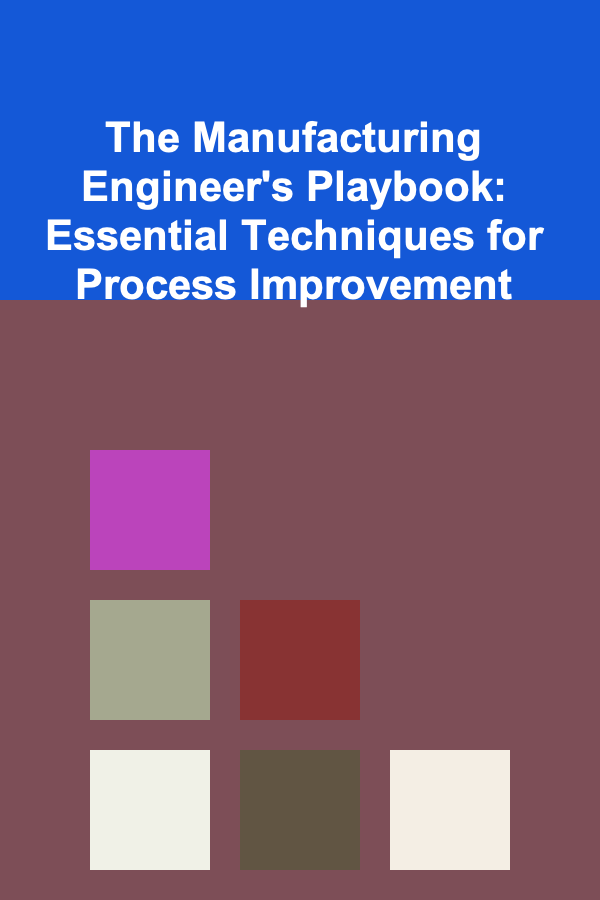
The Manufacturing Engineer's Playbook: Essential Techniques for Process Improvement
ebook include PDF & Audio bundle (Micro Guide)
$12.99$5.99
Limited Time Offer! Order within the next:

Manufacturing engineers play a critical role in driving operational efficiency, ensuring quality control, and implementing continuous improvement initiatives within production environments. In an ever-evolving industry where efficiency, cost reduction, and quality control are paramount, manufacturing engineers must have a robust toolkit of techniques to streamline processes, minimize waste, and optimize performance. This actionable guide outlines essential techniques for process improvement, providing manufacturing engineers with the strategies they need to transform operations and deliver long-term success.
Value Stream Mapping (VSM)
What is Value Stream Mapping?
Value Stream Mapping (VSM) is a lean manufacturing technique used to analyze and design the flow of materials and information required to bring a product to the customer. The primary goal of VSM is to identify and eliminate waste (non-value-adding activities) in the production process, thus improving overall efficiency.
How to Implement VSM:
-
Step 1: Map the Current State
Begin by creating a map of the current production process. This includes all steps, from raw material procurement to final delivery. Capture information about cycle times, lead times, and inventory at each stage.
-
Step 2: Identify Waste
Use the VSM to highlight areas of waste, such as overproduction, excess inventory, waiting time, unnecessary motion, and defects.
-
Step 3: Design the Future State
Once you've identified the inefficiencies, design an ideal "future state" for your process with improvements aimed at eliminating or reducing waste. This future state map should focus on continuous flow, reduced cycle times, and enhanced product quality.
-
Step 4: Implement Improvements
Develop an action plan to implement changes and continuously monitor the process to ensure sustained improvements.
Key Benefits:
- Improved process flow and reduced lead times
- Identifying bottlenecks and inefficiencies
- Enhanced collaboration across teams
Six Sigma Methodology
What is Six Sigma?
Six Sigma is a data-driven methodology aimed at improving process quality by identifying and removing the causes of defects and variation in manufacturing. The methodology follows a structured approach known as DMAIC (Define, Measure, Analyze, Improve, and Control).
How to Implement Six Sigma:
-
Step 1: Define
Clearly define the problem you are trying to solve, the project goals, and the scope. Work with stakeholders to set realistic expectations.
-
Step 2: Measure
Gather data related to the process and measure current performance. This could include defect rates, cycle times, or other performance metrics that are relevant to your project.
-
Step 3: Analyze
Use statistical tools to analyze the data and identify root causes of variation or defects. Tools like Pareto charts, fishbone diagrams, and histograms can help.
-
Step 4: Improve
Based on your analysis, propose and implement improvements. This might include process redesign, automation, or employee training.
-
Step 5: Control
After improvements have been implemented, establish control measures to ensure the process remains stable and improvements are maintained.
Key Benefits:
- Reduction in defects and rework
- Enhanced consistency and predictability in manufacturing processes
- Lower operational costs through waste elimination
5S System (Sort, Set in Order, Shine, Standardize, Sustain)
What is the 5S System?
The 5S methodology is a workplace organization technique that ensures cleanliness, efficiency, and productivity in the manufacturing environment. It focuses on creating a clean, organized, and safe workspace to minimize waste and increase operational efficiency.
How to Implement 5S:
-
Sort (Seiri)
Eliminate unnecessary items from the workspace. Identify tools, materials, and equipment that are not required and remove them. This helps reduce clutter and frees up space.
-
Set in Order (Seiton)
Organize all essential items so they are easy to access and use. Tools, materials, and equipment should be arranged in a logical order to enhance workflow.
-
Shine (Seiso)
Regularly clean and inspect the workspace to maintain cleanliness. A clean workspace reduces the risk of defects and accidents while promoting employee engagement.
-
Standardize (Seiketsu)
Develop standardized procedures and guidelines for all processes. Ensure everyone is following the same set of practices for maintaining the workspace, cleaning, and organizing.
-
Sustain (Shitsuke)
Ensure that the 5S practices are maintained over time. This requires regular audits and the establishment of a culture of continuous improvement.
Key Benefits:
- Increased productivity and reduced downtime
- Improved employee morale and engagement
- Reduced defects due to a clean and organized environment
Root Cause Analysis (RCA)
What is Root Cause Analysis?
Root Cause Analysis (RCA) is a problem-solving technique that identifies the underlying causes of issues in manufacturing processes. By addressing the root cause, rather than just the symptoms, RCA helps prevent the recurrence of problems.
How to Implement RCA:
-
Step 1: Define the Problem
Clearly define the issue you are facing. Gather data to ensure the problem is understood fully by all team members.
-
Step 2: Collect Data
Gather data related to the issue, including production logs, quality control reports, and other relevant information that may shed light on the cause of the problem.
-
Step 3: Identify Possible Causes
Use tools like the Fishbone Diagram (Ishikawa) or the 5 Whys technique to identify possible causes. The 5 Whys method involves asking "Why?" repeatedly until the root cause is identified.
-
Step 4: Implement Solutions
Once the root cause is identified, develop and implement solutions to address it. This could involve process adjustments, equipment repairs, or employee training.
-
Step 5: Monitor and Evaluate
After the solution is implemented, monitor the results to ensure that the problem has been resolved and that improvements are sustained.
Key Benefits:
- Long-term resolution of recurring problems
- Enhanced process reliability and performance
- Prevention of defects and quality issues
Total Productive Maintenance (TPM)
What is TPM?
Total Productive Maintenance (TPM) is an approach that emphasizes proactive and preventive maintenance to maximize equipment uptime and efficiency. TPM involves everyone in the organization, from operators to managers, to ensure the maintenance of equipment is a shared responsibility.
How to Implement TPM:
-
Step 1: Autonomous Maintenance
Train operators to take responsibility for basic maintenance tasks such as cleaning, lubrication, and inspection. This helps identify issues before they escalate.
-
Step 2: Planned Maintenance
Establish a schedule for routine maintenance tasks to prevent equipment breakdowns. This includes checking for wear and tear, replacing parts, and performing inspections.
-
Step 3: Training and Education
Ensure all employees receive proper training in both equipment operations and maintenance. A well-trained workforce is essential for preventing downtime and ensuring efficiency.
-
Step 4: Continuous Improvement
Use data and feedback from maintenance activities to continuously improve the TPM system. Focus on eliminating bottlenecks and improving overall equipment effectiveness (OEE).
Key Benefits:
- Reduced equipment downtime
- Increased equipment lifespan
- Lower repair and maintenance costs
Kaizen (Continuous Improvement)
What is Kaizen?
Kaizen is a Japanese philosophy that focuses on continuous, incremental improvements to processes, products, and workplace culture. Unlike large-scale changes, Kaizen encourages small, consistent improvements that lead to significant long-term results.
How to Implement Kaizen:
-
Step 1: Establish a Kaizen Team
Form a cross-functional team that includes employees from all areas of the manufacturing process. This ensures diverse perspectives and a more holistic approach to improvements.
-
Step 2: Identify Improvement Areas
Encourage team members to suggest areas where improvements can be made. These can be anything from workflow changes to eliminating small inefficiencies.
-
Step 3: Implement Small Changes
Begin by making small, manageable changes to the process. For example, reorganize a workstation to minimize motion or streamline communication protocols.
-
Step 4: Evaluate and Standardize
Once improvements have been tested and proven effective, standardize the new process and share the best practices across the organization.
Key Benefits:
- Incremental improvements that add up over time
- Empowerment of employees to contribute to process improvements
- Cultivation of a culture of continuous learning and adaptation
Conclusion
Manufacturing engineers are at the forefront of process improvement initiatives, driving efficiency, quality, and sustainability in production environments. The techniques outlined in this playbook---Value Stream Mapping, Six Sigma, 5S, Root Cause Analysis, TPM, and Kaizen---are all powerful tools that can help engineers optimize processes, eliminate waste, and enhance overall productivity.
By systematically applying these methodologies and fostering a culture of continuous improvement, manufacturing engineers can significantly impact their organization's bottom line and maintain a competitive edge in the market.

How to Create an Emergency Contact List for Seniors
Read More
How to Organize a Family Talent Show and Art Exhibition
Read More
How to Organize Your Home Library by Color or Size
Read More
How to Understand Rental Property Investing for Passive Income
Read More
Maintenance Mastery: Strategies and Insights from Industry Experts
Read More
Exploring Hydrokinetic Energy from Rivers: A Deep Dive
Read MoreOther Products

How to Create an Emergency Contact List for Seniors
Read More
How to Organize a Family Talent Show and Art Exhibition
Read More
How to Organize Your Home Library by Color or Size
Read More
How to Understand Rental Property Investing for Passive Income
Read More
Maintenance Mastery: Strategies and Insights from Industry Experts
Read More